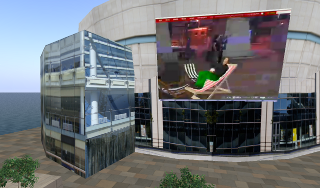Manchester-based virtual world development firm Second Places helped two U.K. universities with an immersive art installation which ran through this past weekend.
The installation, produced by the University and Salford and Liverpool’s John Moore University, was part of the ISEA2009, and international electronic art symposium in the U.K. and Ireland. The installation ran from August 23 to August 29 and included a virtual world version of Belfast’s Waterfront Hall. The installation also mixed together visitors in the virtual and physical buildings.

The installation was located on a dedicated virtual world running on the OpenSim platform.
“It all went really well,” said Olli Aro, chief technology officer at Second Places Ltd. “Not massive audience but really good feedback.”
According to Aro, there were between 20 and 100 daily visitors — real life visitors — to the installation. There were no virtual visiors, aside from the virtual actors who were actually part of the art project.
The installation includes avatars who move automatically in response to motion detectors, creating the effect of interacting with the physical visitors.
According to Aro, OpenSim was chosen as the platform because of its integration capabilities.
“We needed to get in real time data from sensors in our barbeque and motion detectors in the real life part of the installation,” he said. “The real life data then controlled the virtual barbeque and robot avatars in the virtual world part of the installation. With Second Life there is all kind of limitations for this and also servers are hosted quite far away so there is additional delay in that sense.
OpenSim is still alpha software, so most users expect some degree of instability, but Aro said that there were technical problems at the installation.
The reason for using OpenSim was the integration. We needed to get in real time data from sensors in our barbecue and motion detectors in the real life part of the installation. The real life data then controlled the virtual barbeque and robot avatars in the virtual world part of the installation. With Second Life there is all kind of limitations for this and also servers are hosted quite far away so there is additional delay in that sense. No technical problems. We did do a lot of fine tuning in order to optimize our motion detection, so that people could walk around the virtual maze property and OpenSim kept impressing us with its flexibility as far as integration is concerned every time we thought we have hit a brick wall.
The installation was followed at the real life location, so the number of virtual participants was limited to virtual actors who where part of the project only. But the real life audience varied probably from 20 to 100 depending on day.
By reflecting on the ironies of contested spaces, and stereotypes in multi-user virtual environments, this project exposes the cultural identity, gender roles, digital consumption and virtual desire within this augmented world.
Staged in the regenerated landscape of the Waterfront Plaza, this utilitarian space will be used as a stage set to represent an augmented garden where we will explore the concept of perimeters and territories, as a metaphor of the local social history.
Artists who worked on this project included Paul Sermon, Charlotte Gould and Peter Appleton, with programming by Alasdair Swenson, Ben Mitchell, and Peter Kelly.
According to Aro, over 500 delegates attended ISEA 2009 at Belfast, and the response to the mixed reality exhibit was enthusiastic.
“Delegates were very keen to interact and participate in the installation,” he said. “Some visitors particularly commented on and liked the way that the project engaged them with on the screen through the use of real objects.”
For example, delegates and avatars cooked real food and virtual food in unison.
“Feedback from ISEA has been great,” said Second Places director Mark Duffy.
Second Places has been working with OpenSim for quite a while now, Duffy told Hypergrid Business. The firm has more than 10 clients running their own grids, he said.
Hosting prices depend on the kind of use the client will need from the OpenSim world, he said. Building and design rates range from 300 to 500 pounds per day (US$480 to $800).
“We work with clients to deliver as much as possible for as little as possible,” he said. “And if we think the project will raise the profile of virtual worlds or Second Places, we can negotiate prices even lower.”
The Waterfront Hall installation wasn’t Second Life’s first foray into art.
The company has also created a replica of the real life Urbis Museum, also on the Manchester region of Second Life, as part of a joint venture with the Manchester Digital Development Agency. The virtual museum has been used to host virtual exhibitions and other events.

Second Places also works with other platforms, including Second Life. One of its most high-profile clients, Domino’s Pizza, built a virtual replica of a pizza shop on Second Life’s Manchester Island — where visitors could order real pizzas for delivery to their real houses.
- Kitely Mega Worlds on sale for $90 per month - July 19, 2024
- OpenSim regions up, actives down with summer heat - July 15, 2024
- People think AIs are conscious. What could this mean for bots in OpenSim? - July 12, 2024
